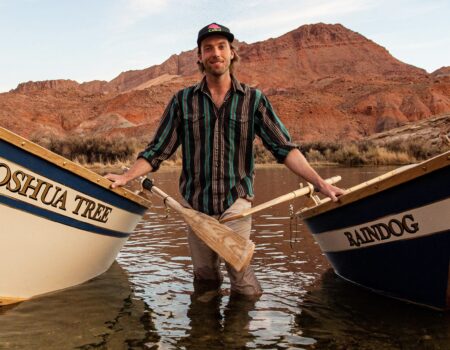
Grand Canyon Youth Partners in Science: Reflections from a Scientist
By Shannon Sartain, Hydrologist
US Geological Survey, Southwest Biological Science Center, Grand Canyon Monitoring and Research Center
(Reprinted with permission by Grand Canyon River Guides & US Geological Survey, as originally published in the Boatman’s Quarterly Review, Vol 36 #4, Winter 2023/2024. Many thanks!)
Since starting at the US Geological Survey (USGS) in 2021, I have been hearing about the magic of Grand Canyon Youth’s (GCY) Partners in Science river trips. On these trips, the USGS and GCY—founded in 1998 by Carol “Fritz” Fritzinger, Martha Clark, and John Hirsh—team up to engage youth in scientific data collection in Grand Canyon. The impacts of Partners in Science trips on the river community are far-reaching: I’ve heard youth share their transformative experiences on the river at GCY’s River Tales and guides describe the wonder in seeing the canyon through the eyes of youth—even my USGS colleague Anya Metcalfe told me she would rather go on a GCY trip than a private trip with her friends. While I find great pride and fulfillment in studying sediment resources of the Colorado River in Grand Canyon in my role at the USGS, I have not-so-secretly harbored dreams of being a science educator and communicator for quite a while now. So, when I saw the call seeking scientists to participate in this summer’s USGS/GCY trips, I jumped on it, wanting to get a taste of this magic myself.
I participated in the Partners in Science trip the last two weeks of July alongside my coworker and friend, river guide-turned-USGS Geographer Erica Byerley, who was on this trip as both a guide and a scientist. Earlier this year, a team of our colleagues including Erica secured funding from the USGS Risk Program to study debris flow risks to campers in the canyon. While the project is focused on distributing existing risk data, some additional on-the-ground investigation was needed—and who better to help collect data than 30 high-school-aged youth? We would be collecting ground-truth observations of, and teaching youth about, debris flows, flash floods, and the risks they pose to campsites and campers. Joining us on the science crew were Craig Ellsworth from Western Area Power Administration and Larry Stevens of general Grand Canyon fame, and in this case, the Springs Stewardship Institute. Together, they planned to sample benthic macroinvertebrate communities in spring-fed tributaries.

Photo credit Shannon Sartain. Erica explaining debris flow and flash flood history at National camp.
While our scientific observations will come later in more official and less embellished formats, what I’ve written here is an attempt to capture the spirit of these incredibly special days to share with the Grand Canyon river community. I say “attempt” because as anyone who has run the Colorado River through the Grand Canyon knows, perfectly describing any trip this meaningful in the Rim World feels impossible, perhaps because, at times, life above the rim cannot stand up to the magic below.
* * *
On July 13th, 2023, the start of some of the hottest days ever recorded in this part of the world, we set off to Lees Ferry. We watched the van’s temperature reading climb up to 105 °F even as the sun was setting, wondering aloud how we would survive a whole trip under these conditions (unfortunately, I had absolutely no consolation for the youth). Anticipating our launch during the mild chaos that makes up rig day, I was filled with my own anxieties: finding my place in the not-a-guide-but-not-a-youth role, teaching geology and geomorphology in addition to conveying a more general understanding of place, and collecting usable scientific observations, all while taking care of myself in nearly 120 °F temperatures. While I sensed some nervousness in the youth— their initial awkward group dynamics vividly took me back to my first extended outdoors experience during college orientation— their fresh energy, desire to get to know each other, and uncomplicated enthusiasm for what we were about to do grounded me. I was excited not only to teach them but to experience the canyon alongside them.

Photo credit Erica Byerley. Shannon teaching youth how to read heights on a survey rod. Yay Science!
We launched the next morning, the world quieting as we pushed off, as it tends to do. It did not take long to feel some of this GCY magic I had heard of. Previously, the only Grand Canyon river trips I had been on were research expeditions, which have packed schedules that don’t typically include side canyon hikes, and certainly not scheduled time for music or art. For others, a first-time trip through the Grand Canyon is more of a bucket list item: a thrill-seeking adventure or a pursuit of a transcendent experience. But thanks to an amazing crew that led this trip with such care and intention, this GCY trip had a refreshing approach made up of fun, learning, scientific data collection, creativity, and exploration of both place and feeling. As we floated, the apprehension I had at the Ferry began to settle out. I chatted with guides, many of whom participated in GCY trips as youth, about why they return to GCY again and again, and with teenagers who blew me away with both the complexity of their generational lexicon (they taught me the term “rizzler”— someone with charisma) and their maturity.
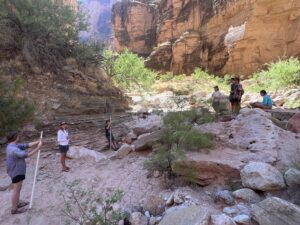
Photo credit Lauren Pacheco. Discussing measurements to take at Upper National camp
As science educators in addition to researchers, Erica and I needed to introduce the basics of debris flow science to the youth before we could begin collecting observations. All of the youth exchanged halfway through the trip via the Bright Angel Trail (on a day Phantom Ranch hit 116 °F — a remarkable physical feat), meaning each group experienced different parts of the canyon and therefore different debris flow deposits and stories. We introduced the first group—energetic, funny, and creative— to our project at Soap Creek Canyon, looking over the >100-foot cut bank and discussing the event in August of 2015 that closed Highway 89A and changed Soap Creek Rapid. We introduced the second group—social, enthusiastic, and curious— to debris flows at Crystal, with a discussion of the post-dam 1966 Crystal Creek flood and depositional event which created the major features of the formidable rapid.
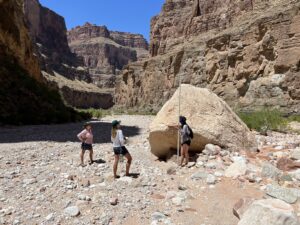
Photo credit Justin Gallen. Measuring the dimensions of a large boulder at National camp
We described the fundamentals of debris flow and flash flood processes in Grand Canyon: how they create debris fans, rapids, sandbars, and campsites, as well as pose risks to humans. We taught them about how both natural and human-made elements of the Grand Canyon ecosystem influence geomorphic processes, like how the geologic units in a drainage affect flash flood risk and how Glen Canyon Dam changes the sediment load and annual and daily hydrographs of the Colorado River. We introduced them to basic surveying techniques, using sight levels, tape measures, and survey rods to measure the height of cutbanks and the size of boulders. The youth were curious and observant, latching on to our teachings and craving more: often, discussions about geomorphic processes, the scientific method, a career in science, or other natural elements of the canyon lasted well beyond designated science time, continuing for an entire boat ride or lunch. In fact, the youth were so attentive, that many evenings upon arriving at camp and noticing the mouth of a large side canyon, they sought professional consultation on where to place their beds.
Larry and Craig engaged the students in their study of aquatic invertebrates at many favorite spring-fed tributaries, sampling at the mouth, up the creek, and on the main stem. While there were certainly rigorous elements of their project— a uniform sampling strategy, discharge measurements, and substrate classification at each site, to name a few— they captured the curiosity of the youth by meeting them at their level of engagement, which often meant looking for and identifying stream bugs. One youth said a favorite part of the trip was being there to find what Larry reported was the first documentation of hellgrammites in Clear Creek. I must emphasize how fortunate we were to have Larry on the trip. He fostered a sense of curiosity through morning lectures, boat ride chats, and answers to unending streams of questions. At night, he joined the science crew for bug light trap collection and identified the interesting critters we caught. He also identified each bug that stung me, often just from a brief description, notably telling me the Latin genus and species name of a bee just seconds after it stung my nose. Larry, if you’re reading, I’m sorry I don’t remember its name— my eyes were still watering from the sting.
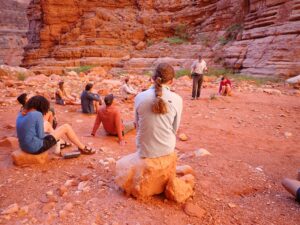
Photo credit Shannon Sartain. Morning lecture from Larry
While we had many chances to teach the youth, they also taught us a lot, especially in their care for each other and the place we were in. A favorite moment of mine highlighting their thoughtfulness was a discussion that happened the night before we visited the Little Colorado River (LCR). Recognizing that the LCR and its confluence with the Colorado River are sacred to many Tribes in the region, it was important that if we were going to visit (and some would say as a non-Native group we should not visit at all), we educate the youth and provide context for reflecting on our presence there. We brought along the Lifeways of the Little Colorado River booklet from the Grand Canyon Trust, in which Ed Kabotie writes in the introduction: “Among certain Indigenous cosmologies, the waters surrounding the confluence are the most sacred places on Earth.” We read aloud excerpts from Tribal members describing their historical and ongoing connections to the LCR in addition to current threats to the river. A student who had previously been on a project-focused GCY trip had studied the proposed Escalade down to the LCR Confluence. She shared with the group the story of the proposal, what it would have meant for the area, and ultimately its shutting down through resistance from local families. After, the group engaged in a long, respectful, and inquisitive conversation about recreating in and developing a place like the LCR Confluence, especially as non-Native people. I reflected later that I did not know many adults who could handle this topic with as much care and humility as the youth did.
The crew of stellar guides and trip coordinators, led by Trip Leader (TL) Justin Gallen, made the trip not just a logistical success but a transformative experience as well. Upper-half Trip Coordinator (TC) Forrest Radarian, full of energy, led a polar plunge nearly every morning of the trip and organized a talent show full of poems and songs and laughs for the last night. Lower-half TC Yann Bosch told stories of his travels via his day job as a commercial airline pilot and connected deeply with the youth via personal conversations, endless riddles, and, most importantly, foot relaxation masks. And the guides— oh, the guides. Garrison Garcia read poetry aloud, slowing us down, and made us laugh with endless jokes (or joke? Is it multiple jokes if you tell the same one every night?). Lauren Pacheco, rowing her first boat through the Grand Canyon, skillfully carried the entire non-guide adult crew, including a 450+ trip veteran, through every single rapid, excitedly and uneventfully. Delaney Cook, in addition to hosting me for front hatch sleepovers, taught block printing and provided professional expertise on Dutch oven pineapple upside-down cake baking to celebrate many birthdays (what are the chances one of the ten adults had a birthday almost every other night for 16 days?). Joe Bruemmer wielded his violin under many night skies and in resonant side canyons, memorably in the morning shade of Redbud Alcove. Erica Byerley, among many less important scientific, logistical, and boating-related accomplishments, got the youth to consume multiple extra jars of hot salsa and bottles of salad dressing via waterfalling shots straight from the containers. And of course, our valiant TL Justin Gallen, despite braving the entire trip without a single piece of candy, made time for nearly every priority science stop, ensured the youth learned and remembered the names of every camp, rapid, and side hike, and managed to land us Poncho’s Kitchen minutes before it started raining.
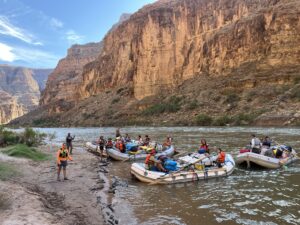
Photo credit Yann Bosch. Launching for our last full day on the water
This brings me to a moment that sums up the spirit of the trip, as evidenced by more than half the group mentioning it as their favorite moment during the end-of-trip ceremony, many through a stream of tears. It was Day 11, two days after the exchange hike, and the lower half group was shaking off their soreness and beginning to gel. We packed lunches, ran Bedrock for breakfast, and hiked up to the Deer Creek patio, spreading out to read, work on block prints, or explore the upper reach of the creek. Clouds started forming, creating a respite from the sun for what felt like the first time all trip (have I mentioned it was hot?). But soon, thunder cracked, echoing off the walls of the slot canyon, prompting our extremely flash flood-aware group to hike back to the boats and find camp. We drifted downstream and soon found ourselves under the Tapeats Sandstone ledges of Poncho’s, anticipating the storm, watching cliff after cliff get enveloped in rain. It was upon us now—drizzling, no, raining, now spitting water. At first, we marveled from under the ledges, watching waterfalls crest over Tapeats Sandstone and Redwall Limestone cliffs and cracking fizzy waters to celebrate the day and now protection from rain. But it was not long before Justin, in a fit of childlike joy, ran out from under the ledges, bringing with him one by one all of the youth and then all of the adults to run out from shelter and look up, get pelted by water, watch a (small) flash flood snake through the far side of camp, dance, do cartwheels, and sing and scream in the joy of rain in the desert. Us adults— in addition to taking the opportunity to test out a citizen science element of the debris flows project, a survey documenting impacts to campsites from an event like this— relished in the bliss of the kids. They had an utter blast, the impromptu science lesson and rain party culminating somehow in a group hair-washing session and many soaking wet smiles.
* * *
These two weeks in July with Grand Canyon Youth were an exceptional reminder of why I love science, and more specifically, why I love learning about the natural world. I have always enjoyed science, but it was not until I started to connect it to my own experiences and see how others connect it to theirs that I really found a drive to pursue it. Yes, understanding how a river carves its banks or what hydraulic conditions are needed to transport house-sized boulders is fascinating. But for me, the beauty of science happens in the reciprocity between scientific processes and how we experience the world. Working in the Grand Canyon is a privilege for so many reasons, and one paramount is how tangible that relationship is. For example, a rapid is not just a geomorphic or hydraulic feature to be studied, nor just an adrenaline-filled whitewater playground— it is both, and each of these interpretations enhances the other. In the case of Lava Falls, debris flows of 1939 and 1955 and 1995 and more deposited material to create features like the ledge hole and the Big Kahuna. And as experienced river runners know firsthand, Lava runs trip after trip at a range of water levels illuminate the principles of physics and hydraulics that comprise such a mighty rapid.

Photo credit Justin Gallen. Upper-half Partners in Science youth at Clear Creek
I am writing as a federally employed researcher, so I will keep my musings about the divine nature of science to a minimum. But I will say, every one of my outdoor experiences has been substantially enriched by my and others’ understandings of geology, ecology, history, and more that make a place what it is. Additionally, my science is more rewarding and comprehensive when I am learning not just from static datasets on a computer, but from the places I frolic in during the day and sleep in at night, the people I am with, and the stories they have. I believe USGS/GCY Partners in Science expeditions embody intimately this sense of curiosity and reciprocity I have come to revere. Youth on these trips, thanks to many people on and off the river who care deeply about the program, gain a deep sense of place by experiencing an adventure imbued with science and learning science loaded with adventure.
The last night of our trip, Justin encouraged the youth to be kind to themselves above the rim and reminded us that Grand Canyon is always a safe space to return to—we can physically visit again, but more importantly, we can always return to this trip in our minds. These past few months, I have returned to these moments often. I am so grateful I got to participate in this Partners in Science trip with a spectacular group of people, and I hope it is not long before I can do it again.
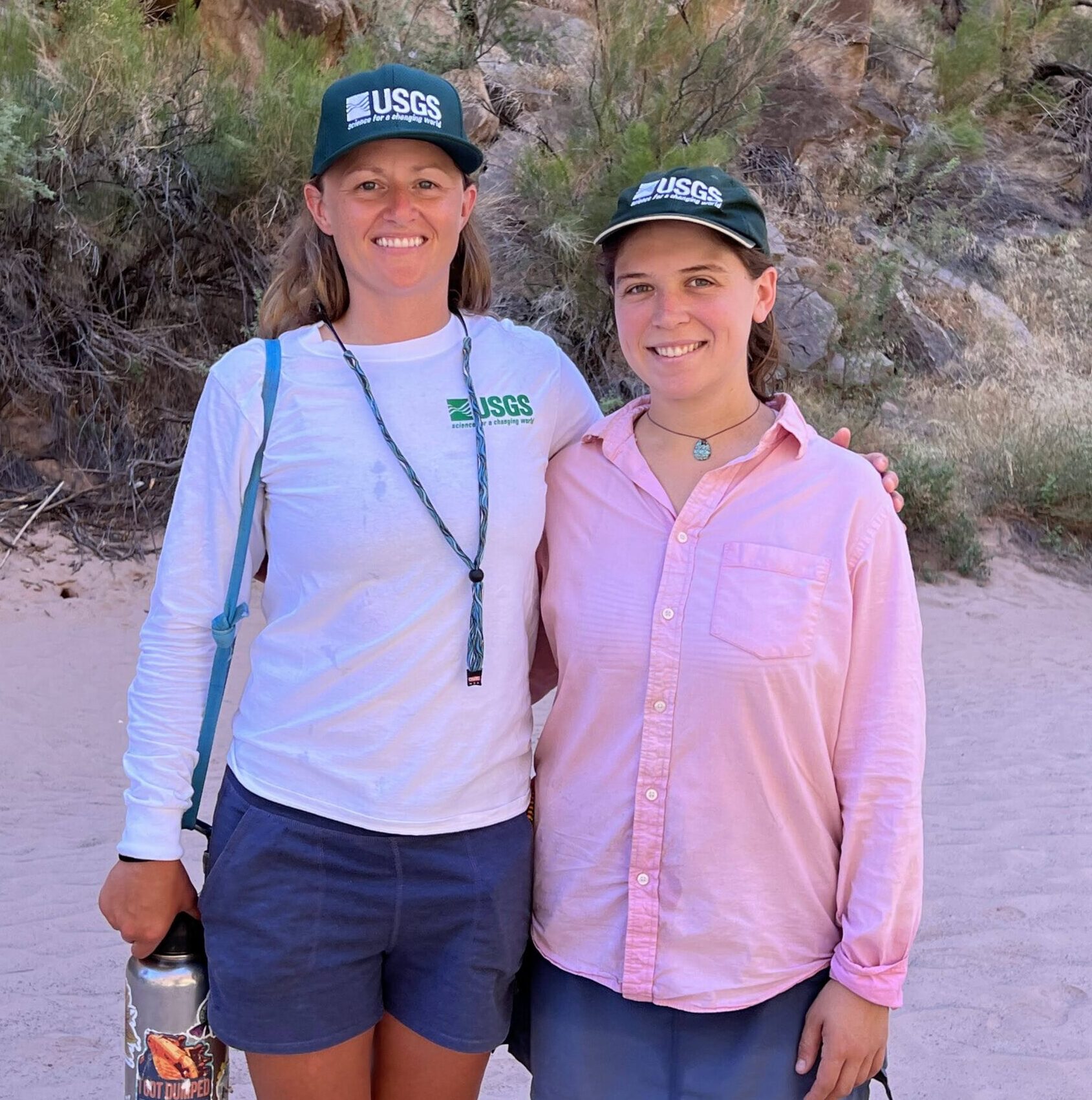
Photo credit Garrison Garcia. Shannon Sartain (right) and Erica Byerley
Shannon Sartain is a Hydrologist at the US Geological Survey, where she has worked since 2021. She is part of the team researching changes in river sediment and sandbars on the Colorado River in Grand Canyon. In July 2023, she participated in her first Grand Canyon Youth trip as a community scientist. Alongside USGS Geographer Erica Byerley, Shannon taught youth about debris flows, flash floods and the risks they pose to campers. She was excited to share the story of this trip and the magic of her time with youth in the Canyon at the 2023 River Tales event, GCY’s annual storytelling fundraiser.

